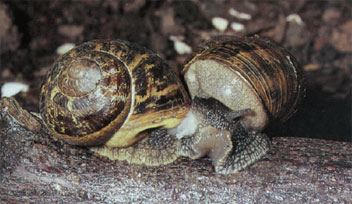Hermaphroditism
Hermaphroditism
Animals that have both male and
female organs in the same individual
are called hermaphrodites, and the
condition is called hermaphroditism.
In contrast to the dioecious
state of separate sexes, hermaphrodites
are monoecious, meaning that both
male and female organs are in the
same organism. Many sessile, burrowing,
or endoparasitic invertebrate animals
(for example, most flatworms,
some hydroids and annelids, and all
barnacles and pulmonate snails) and a
few vertebrates (some fishes), are hermaphroditic.
Some hermaphrodites fertilize
themselves, but most avoid selffertilization
by exchanging germ cells
with another member of the same
species (Figure 7-3). An advantage is
that with every individual producing
eggs, a hermaphroditic species could
potentially produce twice as many offspring
as could a dioecious species in
which half the individuals are nonproductive
males. In some fishes, called sequential hermaphrodites, the animal
experiences a genetically programmed
sex change during its life. In
many species of reef fishes, for example,
the wrasses, the animal begins life
as either a female or a male (depending
on the species) but later becomes
the opposite sex.
 |
| Figure 7-3 Hermaphroditic snails mating. Pulmonate snails are “simultaneous” hermaphrodites, during mating each partner inserts its penis into the female opening of the other. |




